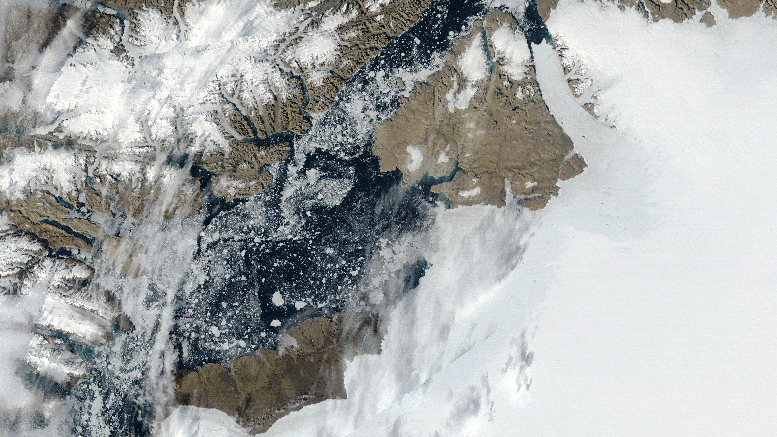Decades of retreat are visible from above, but harder-to-see changes below the waterline could also affect this iconic glacier’s future.
Petermann Glacier is one of Greenland’s largest marine-terminating glaciers. Like most glaciers that discharge ice into the ocean, Petermann periodically sheds large icebergs. But contact with the sea also means warming waters have been melting the glacier’s ice from below, with implications for sea level rise.

Satellite image of Petermann Glacier acquired on August 16, 2002, using the Moderate Resolution Imaging Spectroradiometer (MODIS) on NASA’s Terra satellite.

Satellite image of Petermann Glacier acquired on August 16, 2022, using the Moderate Resolution Imaging Spectroradiometer (MODIS) on NASA’s Terra satellite.
This pair of images, acquired with the Moderate Resolution Imaging Spectroradiometer (MODIS) on NASA’s Terra satellite, shows retreat of the glacier’s floating ice tongue. The upper image shows the glacier in August 2002; the lower image shows the same area two decades later, in August 2022.
Petermann is generally thinning, retreating, and its flow is accelerating. The acceleration stretches and thins the glacier, which makes it more prone to fractures, or rifts, that can break and form an iceberg. Several large icebergs have broken from Petermann during the years spanned by these images, including a 251-square-kilometer berg in 2010, and a 32-square-kilometer berg in 2012. Rifting and periodic iceberg calving are normal parts of an outlet glacier’s life cycle, even in northwest Greenland. Still, these two events reduced the ice tongue by one-third.

Satellite image of Petermann Glacier acquired on May 14, 2023, using the Operational Land Imager (OLI) on Landsat 8.
In 2017, a rift formed near a stream channel running lengthwise along the glacier’s surface. Since then, the “new” rift has converged with an older rift. The merged rifts are visible in this detailed image of the floating ice tongue, acquired on May 14, 2023, with the Operational Land Imager (OLI) on Landsat 8. It remains to be seen if the rift will eventually grow across the width of the glacier and release another large iceberg.
Other signs of action are visible along Petermann’s eastern edge, where the ice of smaller glaciers flowing into the fjord has been mashed up by the more massive Petermann. As a result, a mixture of relatively small, thin icebergs lines the east side of the main glacier.
Meanwhile, warming ocean waters are helping to melt the floating ice tongue from below. This melting might be especially significant along the grounding line—the area where the glacier loses contact with the bedrock and begins to float.
Recent research found that the highest melt rates under Petermann’s floating ice tongue—as much as 80 meters per year—occurred within its grounding zone. Tides can help the warmer seawater reach farther into the grounding zone than previously thought, where it can melt inland ice from below. Unlike meltwater from icebergs or an ice tongue, which are already floating, meltwater from inland ice contributes to sea level rise.
NASA Earth Observatory images by Allison Nussbaum, using MODIS data from NASA EOSDIS LANCE and GIBS/Worldview and Landsat data from the U.S. Geological Survey. Story by Kathryn Hansen with information from Christopher Shuman/UMBC/NASA.
- aum
-

 1
1




Recommended Comments
There are no comments to display.
Join the conversation
You can post now and register later. If you have an account, sign in now to post with your account.
Note: Your post will require moderator approval before it will be visible.